SUBARU TRIBECA 2009 1.G Service Workshop Manual
Manufacturer: SUBARU, Model Year: 2009, Model line: TRIBECA, Model: SUBARU TRIBECA 2009 1.GPages: 2453, PDF Size: 46.32 MB
Page 1711 of 2453
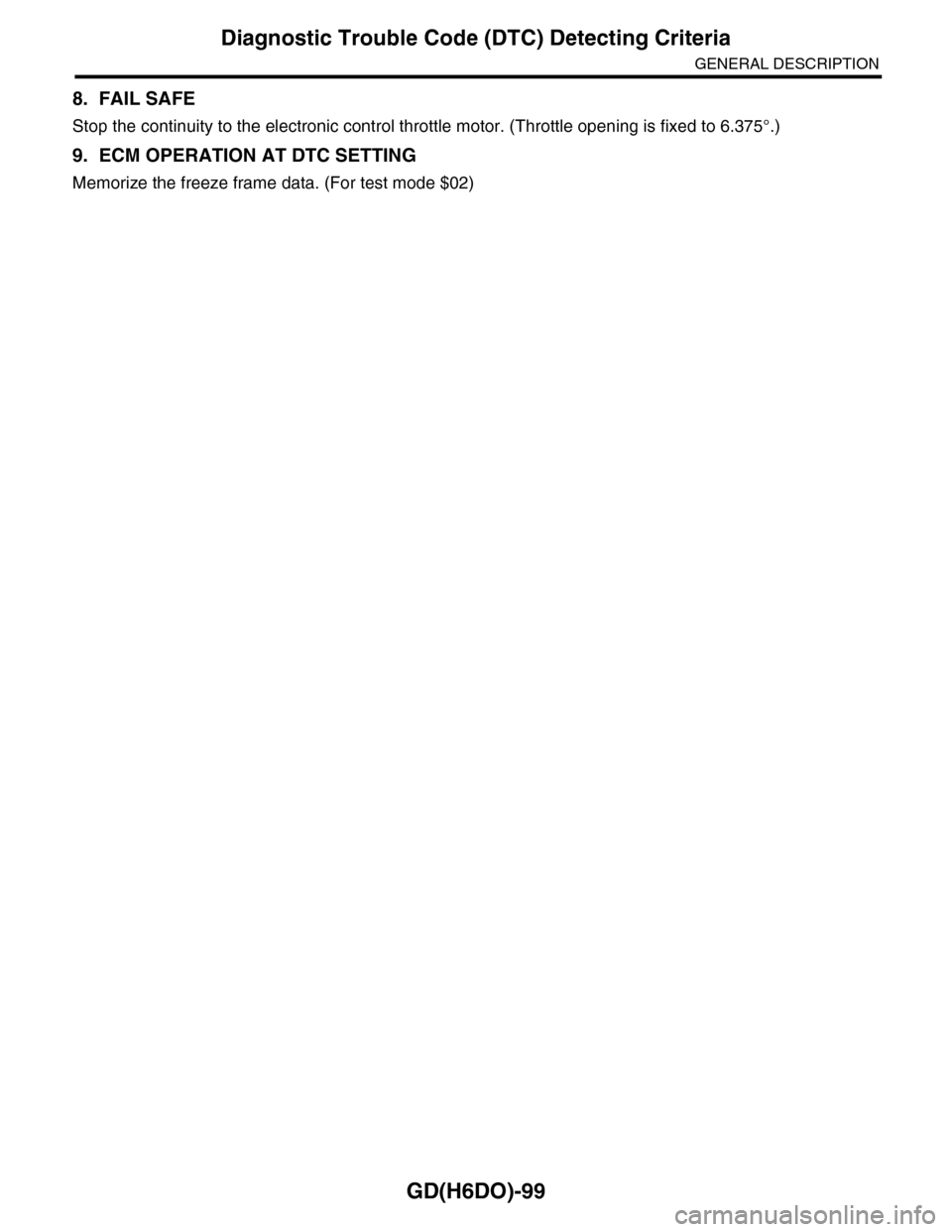
GD(H6DO)-99
Diagnostic Trouble Code (DTC) Detecting Criteria
GENERAL DESCRIPTION
8. FAIL SAFE
Stop the continuity to the electronic control throttle motor. (Throttle opening is fixed to 6.375°.)
9. ECM OPERATION AT DTC SETTING
Memorize the freeze frame data. (For test mode $02)
Page 1712 of 2453

GD(H6DO)-100
Diagnostic Trouble Code (DTC) Detecting Criteria
GENERAL DESCRIPTION
BL:DTC P0223 THROTTLE/PEDAL POSITION SENSOR/SWITCH “B” CIRCUIT
HIGH INPUT
1. OUTLINE OF DIAGNOSIS
Detect the open or short circuit of throttle position sensor 2.
Judge as NG if it is out of specification.
2. COMPONENT DESCRIPTION
3. ENABLE CONDITIONS
4. GENERAL DRIVING CYCLE
Always perform the diagnosis continuously.
5. DIAGNOSTIC METHOD
Judge as OK and clear the NG when the malfunction criteria below are met.
Time Needed for Diagnosis: 24 milliseconds
Malfunction Indicator Light: Illuminates as soon as a malfunction occurs.
6. DTC CLEAR CONDITION
•When the OK idling cycle is completed 40 times in a row
•When “Clear Memory” is performed (Only engine stop)
7. MALFUNCTION INDICATOR LIGHT CLEAR CONDITIONS
•When the OK driving cycle is completed 3 times in a row
•When “Clear Memory” is performed (Only engine stop)
(1) Throttle position sensor 1 signal. (3) Throttle position sensor (4) Engine control module (ECM)
(2) Throttle position sensor 2 signal.
Secondary Parameters Enable Conditions
Ignition switch ON
Judgment Value
Malfunction Criteria Threshold Value
Sensor 2 input voltage≤ 4.851 V
EN-01859
(1)
(2)
(3)(4)
Page 1713 of 2453
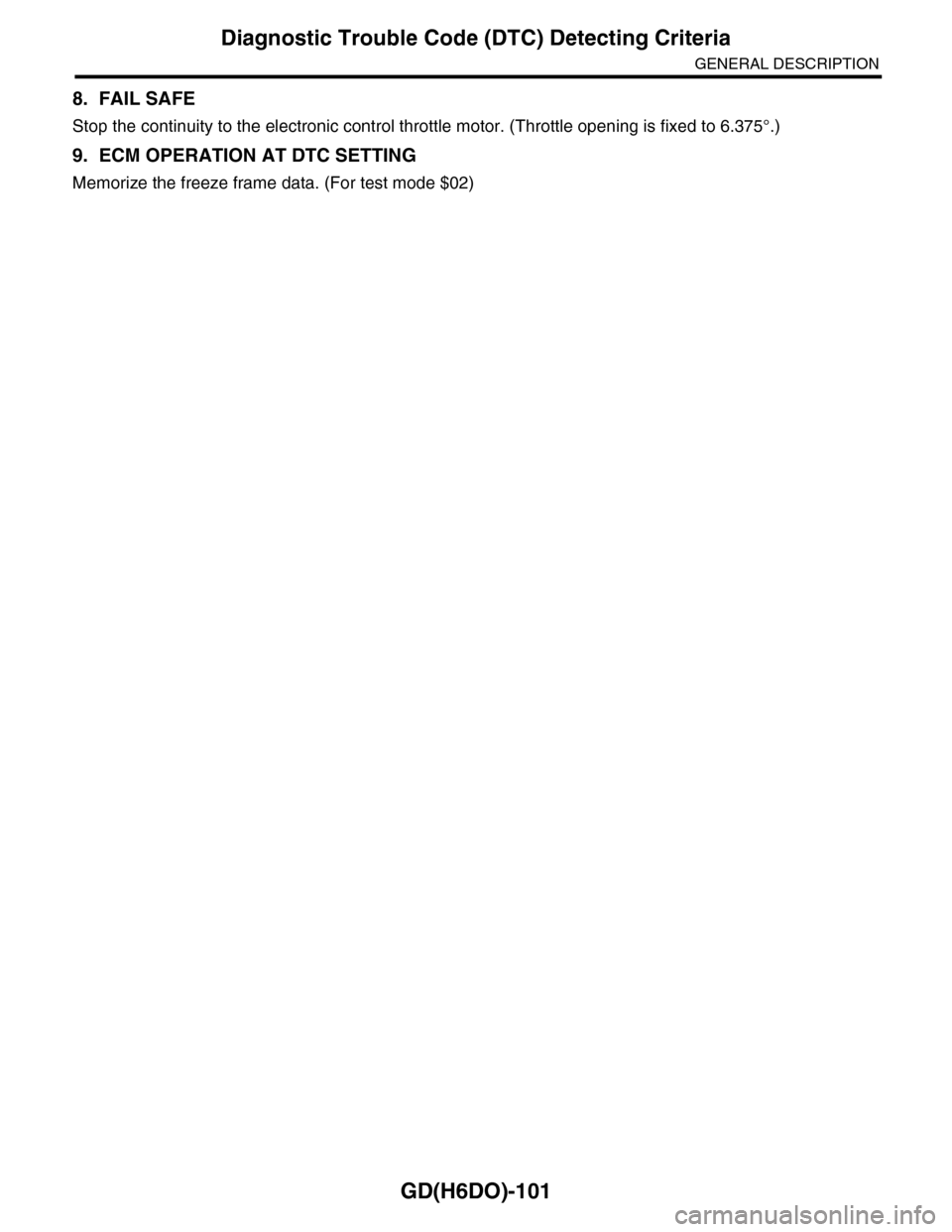
GD(H6DO)-101
Diagnostic Trouble Code (DTC) Detecting Criteria
GENERAL DESCRIPTION
8. FAIL SAFE
Stop the continuity to the electronic control throttle motor. (Throttle opening is fixed to 6.375°.)
9. ECM OPERATION AT DTC SETTING
Memorize the freeze frame data. (For test mode $02)
Page 1714 of 2453
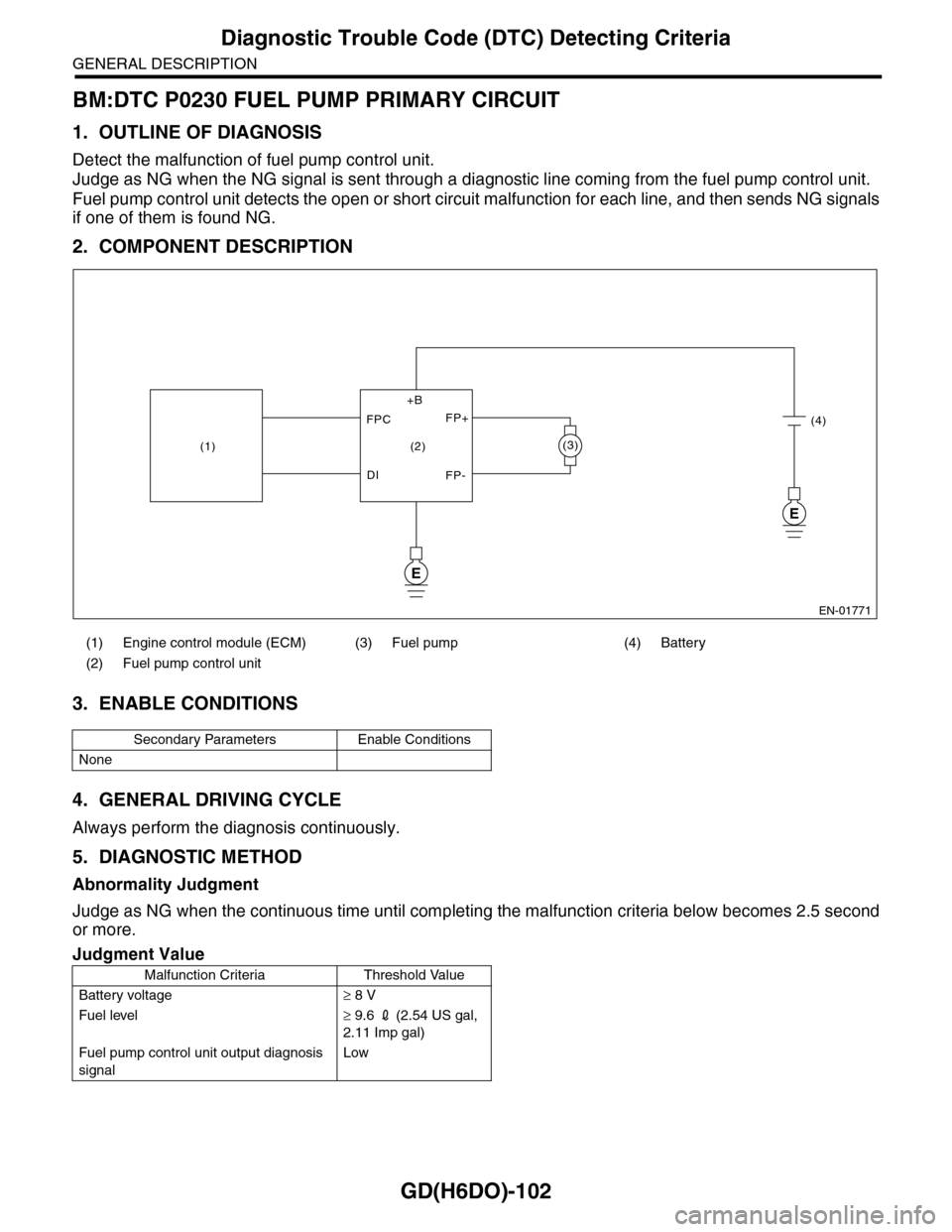
GD(H6DO)-102
Diagnostic Trouble Code (DTC) Detecting Criteria
GENERAL DESCRIPTION
BM:DTC P0230 FUEL PUMP PRIMARY CIRCUIT
1. OUTLINE OF DIAGNOSIS
Detect the malfunction of fuel pump control unit.
Judge as NG when the NG signal is sent through a diagnostic line coming from the fuel pump control unit.
Fuel pump control unit detects the open or short circuit malfunction for each line, and then sends NG signals
if one of them is found NG.
2. COMPONENT DESCRIPTION
3. ENABLE CONDITIONS
4. GENERAL DRIVING CYCLE
Always perform the diagnosis continuously.
5. DIAGNOSTIC METHOD
Abnormality Judgment
Judge as NG when the continuous time until completing the malfunction criteria below becomes 2.5 second
or more.
(1) Engine control module (ECM) (3) Fuel pump (4) Battery
(2) Fuel pump control unit
Secondary Parameters Enable Conditions
None
Judgment Value
Malfunction Criteria Threshold Value
Battery voltage≥ 8 V
Fuel level≥ 9.6 2 (2.54 US gal,
2.11 Imp gal)
Fuel pump control unit output diagnosis
signal
Low
EN-01771
E
E
(3)
(4)
(2)
FPC
DI
FP+
FP-
+B
(1)
Page 1715 of 2453
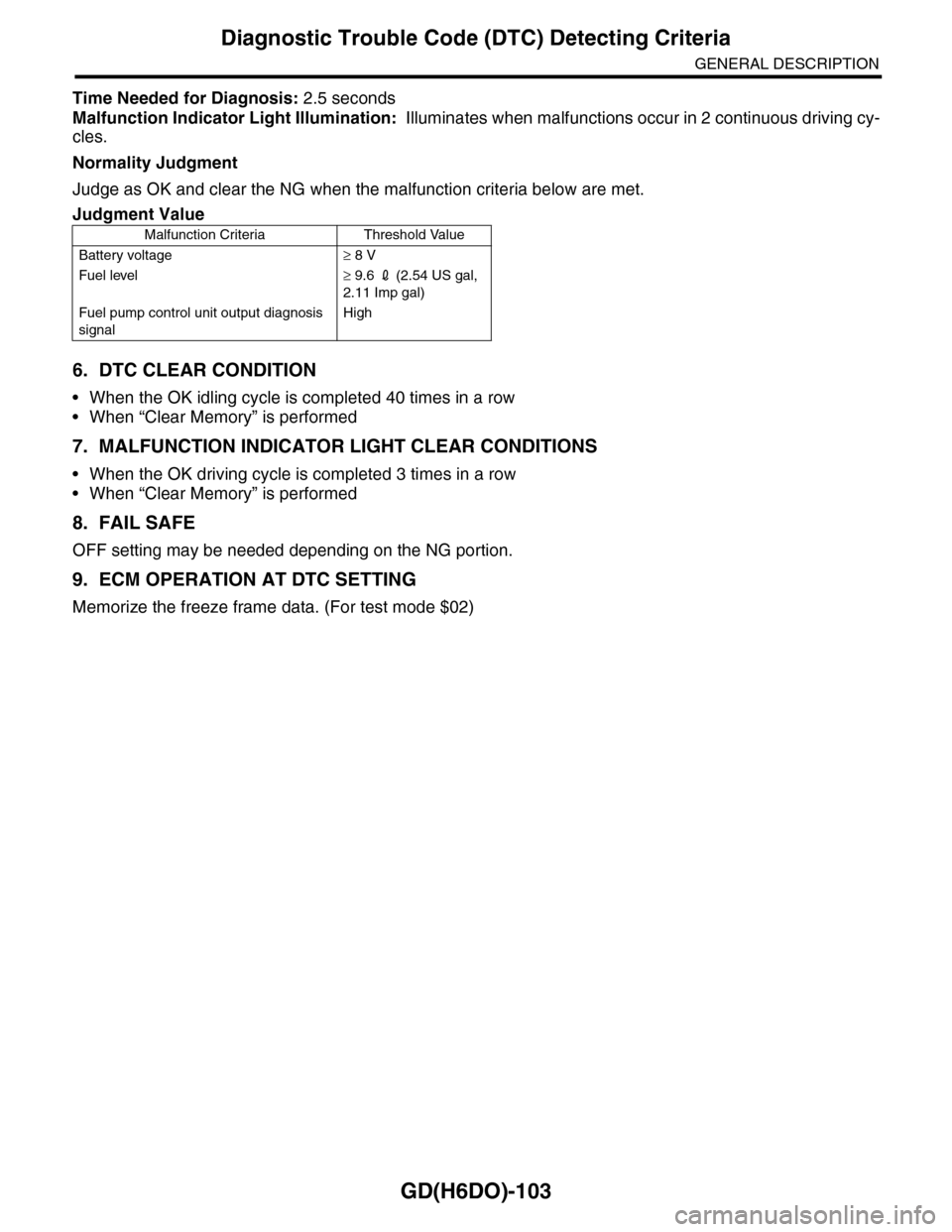
GD(H6DO)-103
Diagnostic Trouble Code (DTC) Detecting Criteria
GENERAL DESCRIPTION
Time Needed for Diagnosis: 2.5 seconds
Malfunction Indicator Light Illumination: Illuminates when malfunctions occur in 2 continuous driving cy-
cles.
Normality Judgment
Judge as OK and clear the NG when the malfunction criteria below are met.
6. DTC CLEAR CONDITION
•When the OK idling cycle is completed 40 times in a row
•When “Clear Memory” is performed
7. MALFUNCTION INDICATOR LIGHT CLEAR CONDITIONS
•When the OK driving cycle is completed 3 times in a row
•When “Clear Memory” is performed
8. FAIL SAFE
OFF setting may be needed depending on the NG portion.
9. ECM OPERATION AT DTC SETTING
Memorize the freeze frame data. (For test mode $02)
Judgment Value
Malfunction Criteria Threshold Value
Battery voltage≥ 8 V
Fuel level≥ 9.6 2 (2.54 US gal,
2.11 Imp gal)
Fuel pump control unit output diagnosis
signal
High
Page 1716 of 2453

GD(H6DO)-104
Diagnostic Trouble Code (DTC) Detecting Criteria
GENERAL DESCRIPTION
BN:DTC P0301 CYLINDER 1 MISFIRE DETECTED
1. OUTLINE OF DIAGNOSIS
Detect the presence of misfire occurrence. (Revolution fluctuation method)
Monitoring Misfire which influences exhaust deterioration (1.5 times of FTP) and catalyst damage is made
obligatory by the law. Misfire affecting these two has three patterns below. Intermittent misfire (Different cyl-
inders misfire intermittently.):
•Intermittent misfire (The same cylinder misfires in random, or different cylinders misfire in random.): FTP
1.5 times misfire
•Every time misfire (The same cylinder misfires every time.): FTP 1.5 times misfire, Catalyst damage misfire
The following detecting methods are adopted for these detection.
1) Intermittent misfire: FTP 1.5 times misfire
•120° Interval Difference Method
•360° Interval Difference Method (whole range)
•720° Interval Difference Method (3,000 rpm or less)
2) Misfire every time: FTP 1.5 times misfire, Catalyst damage misfire
•360° Interval Difference Method
2. ENABLE CONDITIONS
Map 3
3. GENERAL DRIVING CYCLE
•If conditions are met, detect misfire from idling to high rotation.
•Perform the diagnosis continuously.
Secondary Parameters Enable Conditions
All secondary parameters enable condi-
tions
1 second or more
120° Intake manifold pressure change at
CA
< 20 kPa (150 mmHg,
5.9 inHg)
Throttle position change during 16 milli-
seconds
< 20°
Fuel shut-off function Not in operation
Fuel level≥ 9.6 2 (2.54 US gal,
2.11 Imp gal)
Ve h i c l e d y n a m i c c o n t r o l o r AT t o r q u e
control
Not in operation
Evaporative system leak check Not in operation
Engine speed 400 — 8000 rpm
Intake manifold pressure >Value of Map 3 or
more
Battery voltage≥ 8 V
Atmospheric pressure≥ 75.0 kPa (563
mmHg, 22.17 inHg)
Fuel parameter determination Not extremely low vol-
atility
rpm 700 1000 1500 2000 2500 3000 3500 4000 4500 5000 5500 6000 6500 7000
kPa
(mmHg,
inHg)
26.7
(200.0,
7.87)
26.7
(200.0,
7.87)
24.0
(180.0,
7.09)
24.1
(181.0,
7.13)
24.3
(182.0,
7.17)
24.7
(185.0,
7.28)
28.3
(212.3,
8.36)
30.9
(232.1,
9.14)
32.9
(247.0,
9.72)
33.1
(248.0,
9.76)
34.3
(257.0,
10.12)
38.1
(286.0,
11.26)
41.9
(314.0,
12.36)
48.9
(367.0,
14.45)
Page 1717 of 2453

GD(H6DO)-105
Diagnostic Trouble Code (DTC) Detecting Criteria
GENERAL DESCRIPTION
4. DIAGNOSTIC METHOD
When a misfire occurs, the engine RPM will decreased and the crankshaft position speed will change. Cal-
culate the interval difference value (diagnostic value) from crankshaft position speed by the following formu-
la, and judge whether a misfire is occurring or not comparing the calculated result with judgment value.
Counting the number of misfires, if the misfire ratio is higher during 1000 rev. or 200 rev. Judge correspond-
ing cylinders as NG.
As shown in the following figure, pick a cylinder as the standard and name it omg 0. And the former crank-
shaft position speed is named omg 1, the second former crankshaft position speed is named omg 2, the third
is named omg 3, etc.
Diagnostic value cal-
culation
(Calculate from angle
speed) →
Misfire detection every single
ignition
(Compare diagnostic value
with judgment value) →
NG judgment (Misfire occurrence judg-
ment required by the law) (Compare
number of misfire with judgment)
•120 degree difference
method
•360 degree difference
method
•720 degree difference
method
•FTP 1.5 times misfire NG judgment
•Catalyst damage misfire NG judgment
(A) Ignition order (B) Crankshaft position speed
EN-02184
#1 #6 #3 #2 #5 #4 #1 #6 #3 #2(A)
(B)omg0omg1omg2omg3omg4omg5omg6omg7
Page 1718 of 2453

GD(H6DO)-106
Diagnostic Trouble Code (DTC) Detecting Criteria
GENERAL DESCRIPTION
120° Interval Difference Method
360° Interval Difference Method
Diagnostic value domg 120 = (omg 1 – omg 0) – (omg 7 – omg 1)/6
Judge as a misfire in the following cases.
•domg 120 > judgment value of positive side
•domg 121 ≤ judgment value of negative side
(Judgment value before 120°CA)
Diagnostic value domg 360 = (omg 1 – omg 0) – (omg 4 – omg 3)
Misfire judgment domg 360 > Judgment value → Judge as misfire
EN-02185
TO JUDGE A MISFIRE
THRESHOLD VALUE (PLUS)
THRESHOLD VALUE (MINUS)
domg120
domg120
EN-02279
TO JUDGE A MISFIRE
THRESHOLD VALUE
domg360
domg360
Page 1719 of 2453
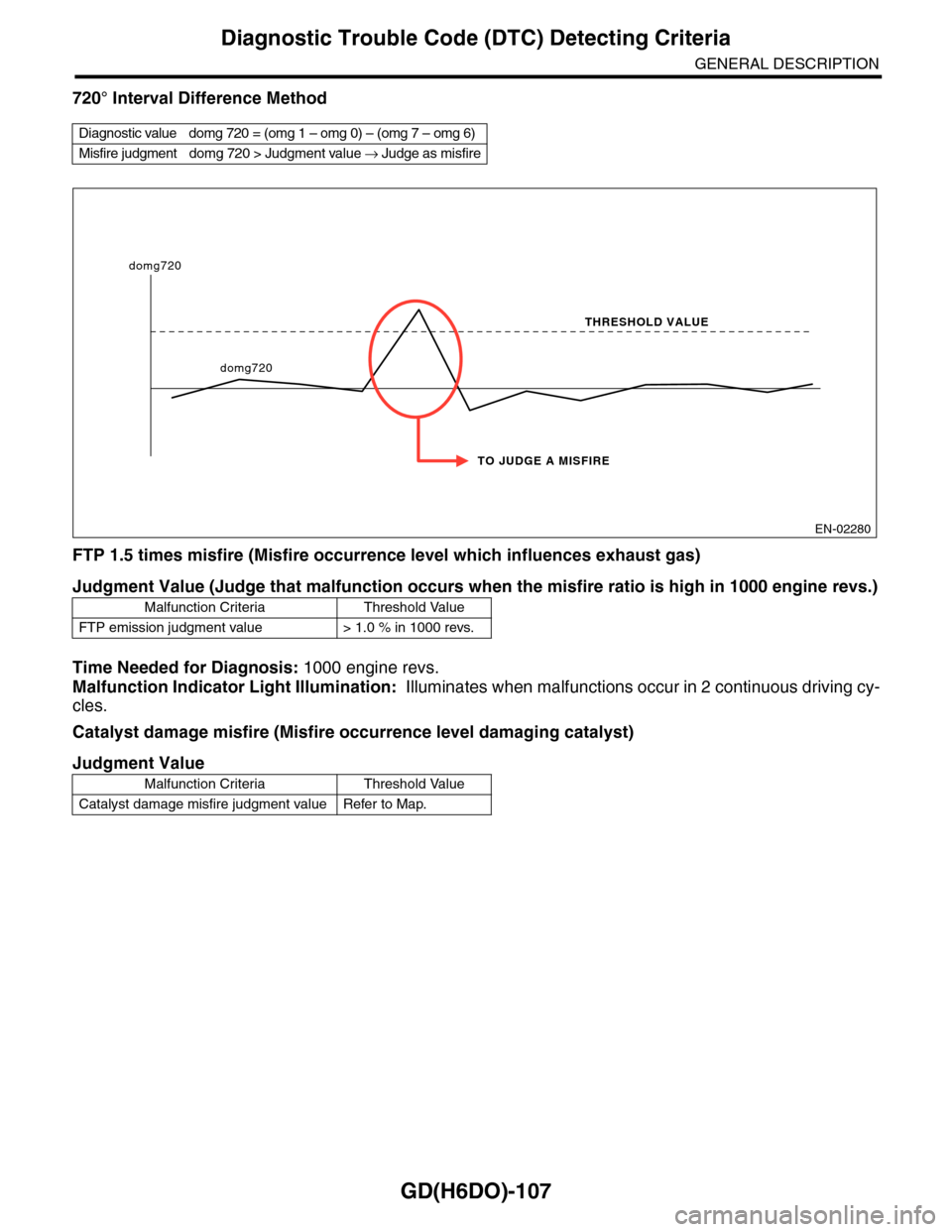
GD(H6DO)-107
Diagnostic Trouble Code (DTC) Detecting Criteria
GENERAL DESCRIPTION
720° Interval Difference Method
FTP 1.5 times misfire (Misfire occurrence level which influences exhaust gas)
Time Needed for Diagnosis: 1000 engine revs.
Malfunction Indicator Light Illumination: Illuminates when malfunctions occur in 2 continuous driving cy-
cles.
Catalyst damage misfire (Misfire occurrence level damaging catalyst)
Diagnostic value domg 720 = (omg 1 – omg 0) – (omg 7 – omg 6)
Misfire judgment domg 720 > Judgment value → Judge as misfire
Judgment Value (Judge that malfunction occurs when the misfire ratio is high in 1000 engine revs.)
Malfunction Criteria Threshold Value
FTP emission judgment value > 1.0 % in 1000 revs.
Judgment Value
Malfunction Criteria Threshold Value
Catalyst damage misfire judgment value Refer to Map.
EN-02280
TO JUDGE A MISFIRE
THRESHOLD VALUE
domg720
domg720
Page 1720 of 2453
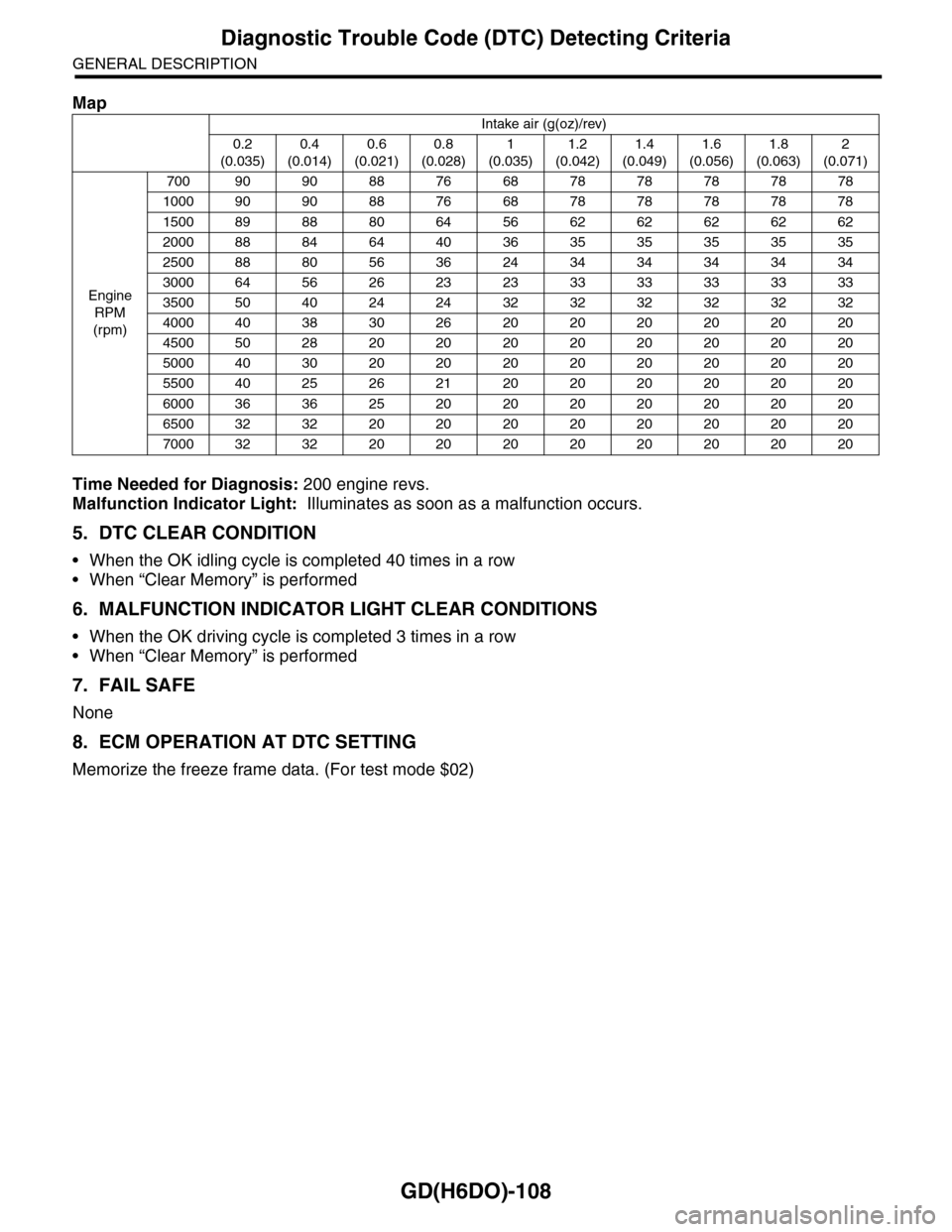
GD(H6DO)-108
Diagnostic Trouble Code (DTC) Detecting Criteria
GENERAL DESCRIPTION
Time Needed for Diagnosis: 200 engine revs.
Malfunction Indicator Light: Illuminates as soon as a malfunction occurs.
5. DTC CLEAR CONDITION
•When the OK idling cycle is completed 40 times in a row
•When “Clear Memory” is performed
6. MALFUNCTION INDICATOR LIGHT CLEAR CONDITIONS
•When the OK driving cycle is completed 3 times in a row
•When “Clear Memory” is performed
7. FAIL SAFE
None
8. ECM OPERATION AT DTC SETTING
Memorize the freeze frame data. (For test mode $02)
Map
Intake air (g(oz)/rev)
0.2
(0.035)
0.4
(0.014)
0.6
(0.021)
0.8
(0.028)
1
(0.035)
1.2
(0.042)
1.4
(0.049)
1.6
(0.056)
1.8
(0.063)
2
(0.071)
Engine
RPM
(rpm)
700 90 90 88 76 68 78 78 78 78 78
1000 90 90 88 76 68 78 78 78 78 78
1500 89 88 80 64 56 62 62 62 62 62
2000 88 84 64 40 36 35 35 35 35 35
2500 88 80 56 36 24 34 34 34 34 34
3000 64 56 26 23 23 33 33 33 33 33
3500 50 40 24 24 32 32 32 32 32 32
4000 40 38 30 26 20 20 20 20 20 20
4500 50 28 20 20 20 20 20 20 20 20
5000 40 30 20 20 20 20 20 20 20 20
5500 40 25 26 21 20 20 20 20 20 20
6000 36 36 25 20 20 20 20 20 20 20
6500 32 32 20 20 20 20 20 20 20 20
7000 32 32 20 20 20 20 20 20 20 20